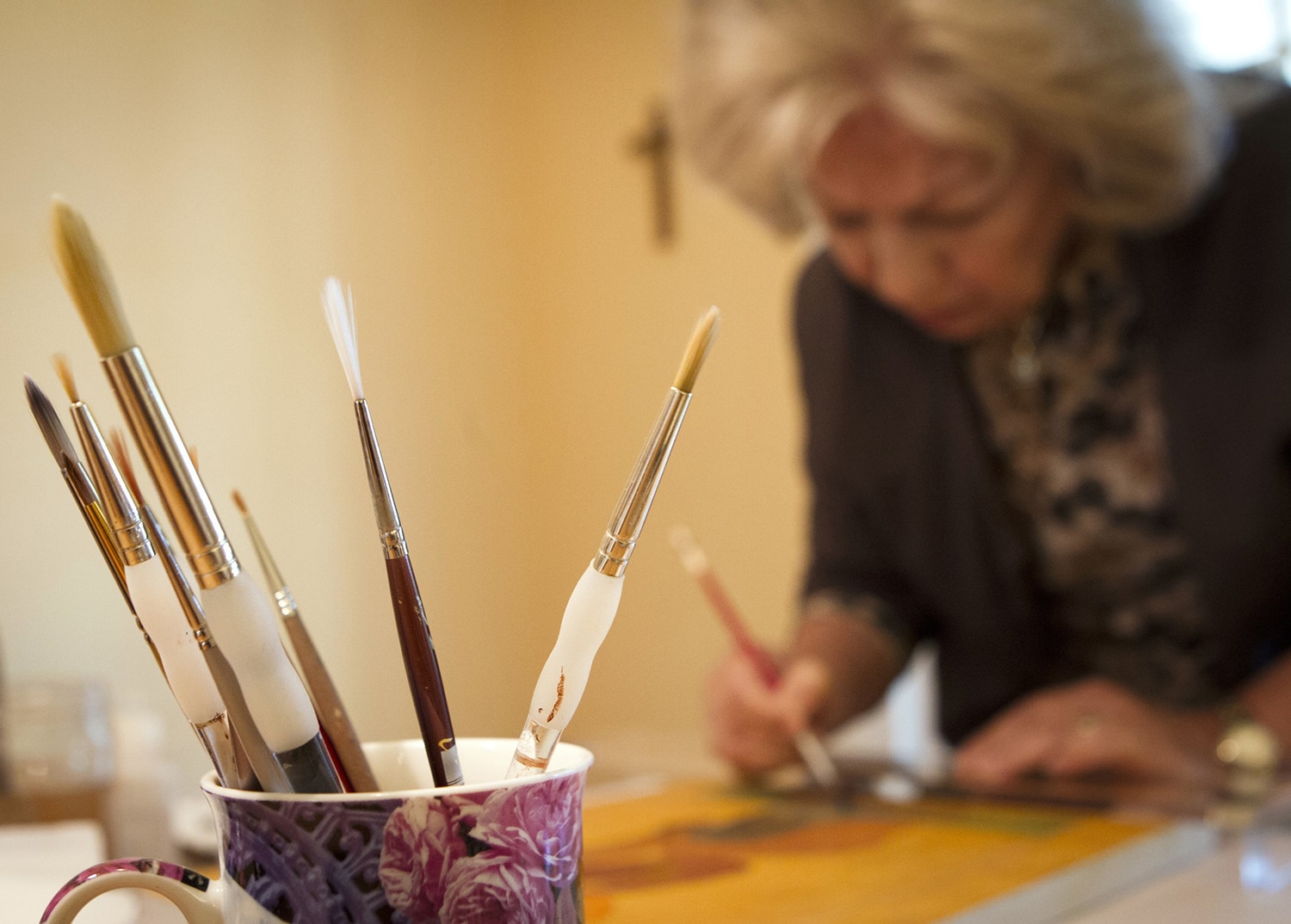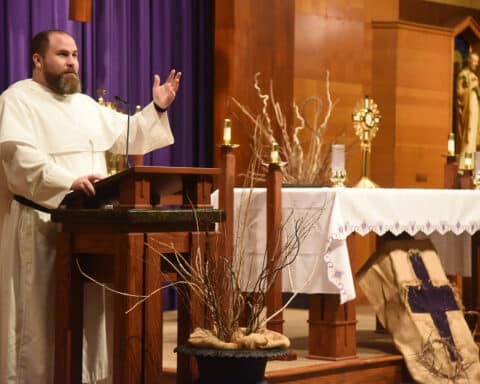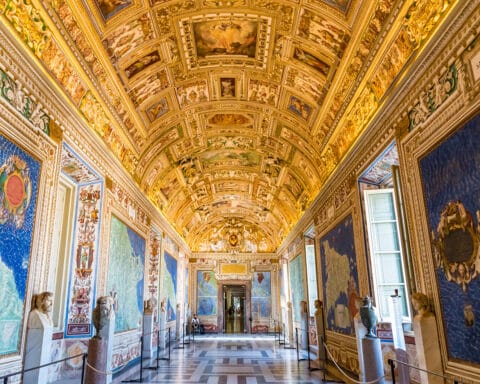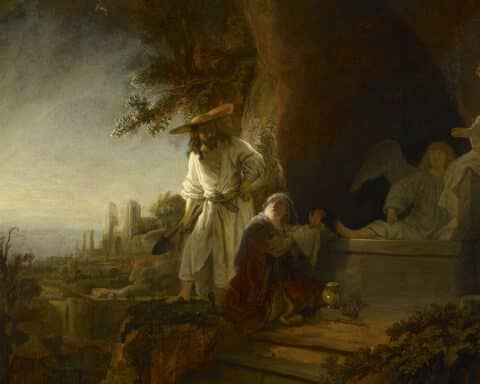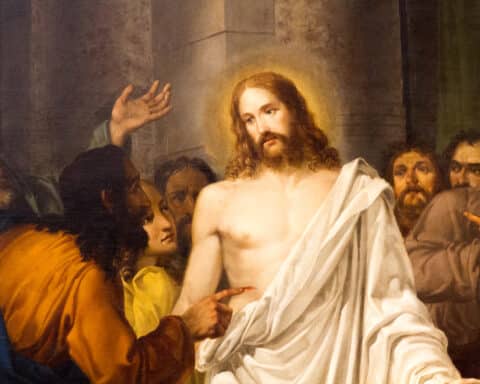Ahead of the 10th National Eucharistic Congress, artists nationwide are invited to enter a “National Eucharistic Art Competition.”
Emphasizing the relationship between art and faith, the National Eucharistic Revival team, in partnership with St. Edmund’s Sacred Art Institute on Enders Island in Mystic, Connecticut, is welcoming artists to submit original art with a Eucharistic theme by Feb. 20.
“As sacred artists and as a Sacred Art Institute, we all have a responsibility in the part we are to play in drawing God’s people into a deeper intimacy with our Eucharistic Lord,” Dan DeLouise, an award-winning artist with St. Edmund’s Sacred Art Institute, told Our Sunday Visitor. “A National Eucharistic Sacred Art Exhibit seemed most appropriate.”
The competition — and following exhibitions featuring the winners — participates with the National Eucharistic Revival, a three-year initiative by the U.S. Catholic bishops that seeks to renew the Catholic Church by enkindling a living relationship with Jesus Christ in the holy Eucharist. The grassroots movement culminates in the National Eucharistic Congress, taking place in Indianapolis July 17-21, 2024.
The winning artworks will appear in a 2024 catalog and in exhibitions on Enders Island (April 20-May 5), at the Blessed Michael McGivney Pilgrimage Center in New Haven, Connecticut (May 11-Aug. 25), and at the upcoming congress.
The winning artists will receive cash prizes, with total awards amounting to over $3,000, including $2,000 for first place.
DeLouise, who is organizing the competition, said that they have already received nearly 200 submissions. He, together with Deacon Francis Valliere, the coordinator of St. Edmund’s Sacred Art Institute, will judge the artworks.
The artist expressed excitement on multiple levels for this opportunity.
“First, for the ability of these gifted artists to use their talents to bring forth in both their hearts and those whose eyes rest upon these works a renewed love of our Eucharistic Lord,” DeLouise said. “In addition, it has provided us a unique opportunity to reach out to some of our country’s most exceptional talent and faith-filled artists, some of whom have never had an opportunity in the Sacred Arts such as this made available to them!”
“As sacred artists,” he added, “we long to use our skills to keep the ‘viewer’ interested in the beauty of the works and the scene depicted, for God to move in their hearts toward an intimacy with the Divine.”
He shared that Father Chris Alar, the provincial superior of the Blessed Virgin Mary, Mother of Mercy Province of the Marian Fathers of the Immaculate Conception in the United States and Argentina, will serve as the presenter at the Blessed Michael McGivney Pilgrimage Center during a reception on May 31.
“Ultimately, the love and compassion for our Eucharistic Lord moves us to the extraordinary,” DeLouise said of the inspiration for this opportunity. “The need for a renewed understanding of the truths of our Faith, especially that of the Most Holy Eucharist, has been realized by both religious and laity.”
Entering the competition
Online, St. Edmund’s Sacred Art Institute lists details about entering the competition, including size and weight limitations for submitted art.
“Artwork should emphasize aspects of Truth and Beauty of the Faith,” the website reads. “Executed in a manner worthy of the House of the Lord, depicting sound doctrine, inspired by Eucharistic elements of Biblical or private revelation of the Saints, the Blessed or Servants of God.”
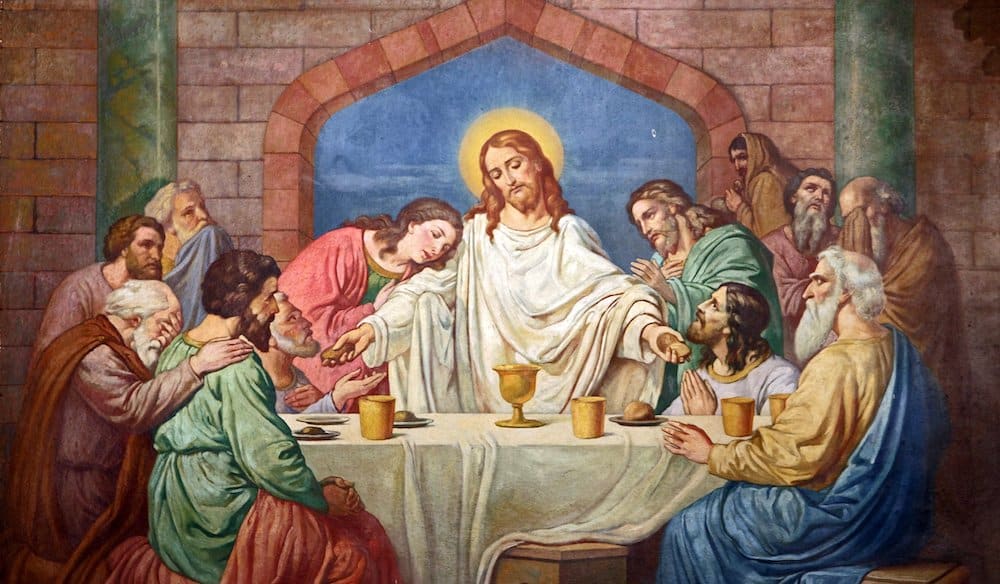
A long list of suggested Eucharistic themes for submissions includes Eucharistic imagery from the Bible (from the collection of manna to the Last Supper), saints of the Eucharist, the Mass, first Communion, and sites of Eucharistic miracles.
The organizers encourage works in classical traditional media and will not accept photography or computer-generated or digital works.
Both professional and amateur artists of any religious background are invited to participate as long as they are U.S. residents over the age of 18. Each person may submit up to six original works with a payment of $25 for one to three submissions or $45 for one to six submissions.
The relationship of art and faith
In a blog announcing the art competition, the revival team emphasized the roles of both the artists and art viewers.
“For the viewer, sacred art offers a unique way to explore the beauty and truth of our faith expressed in a visual way. This is so powerful that many Catholics engage in a prayer method called visio divina as a part of their regular practice,” it reads. “For the artist, this expression of creativity can be both an act of worship and a way to mirror the Creator in whose image we were made.”
Jem Sullivan, associate professor of catechetics in the School of Theology and Religious Studies at Catholic University of American in Washington, D.C., and the author “Way of Beauty: Rekindling Eucharistic Amazement with Visio Divina,” published by OSV in 2023, described the practice of visio divina.
“Visio divina is an adaptation of the ancient monastic prayer practice of lectio divina, so as to pray with sacred images on the ‘way of beauty,'” she told Our Sunday Visitor.
“In lectio divina, we approach sacred Scripture in a prayerful, reflective way so as to hear God’s word in the mind and heart and will,” she continued. “This way of reading the Bible contrasts with the speed reading we usually engage in given the vast amount of information that surrounds us in the digital age.”
Lectio divina, Sullivan said, typically consists of four steps: “namely lectio, or slow, prayerful reading; then meditatio, or silent meditation on a word, phrase or passage; followed by oratio, or prayer where reading turns into prayer; and finally, contemplatio that leads one to rest contemplatively in the presence of God who speaks.”
Sullivan addressed how the beauty of sacred art, particularly Eucharistic art, can deepen the faith of both the artist and the person who views the art.
“Sacred art is created for the sacred context of the Church’s worship in the Eucharist,” she said. “The goal of sacred art is to lead us, through beauty, to encounter the Eucharistic presence of Jesus and to participate more fully in the gift and mystery that is the Eucharist.”
“The beauty of sacred art invites awe and wonder at the gift of the Paschal Mystery of Jesus, the heart of every liturgical celebration,” she concluded, before citing a phrase used by Pope St. John Paul II. “The beauty of sacred art can lead both artist and viewer to experience ‘Eucharistic amazement.'”

